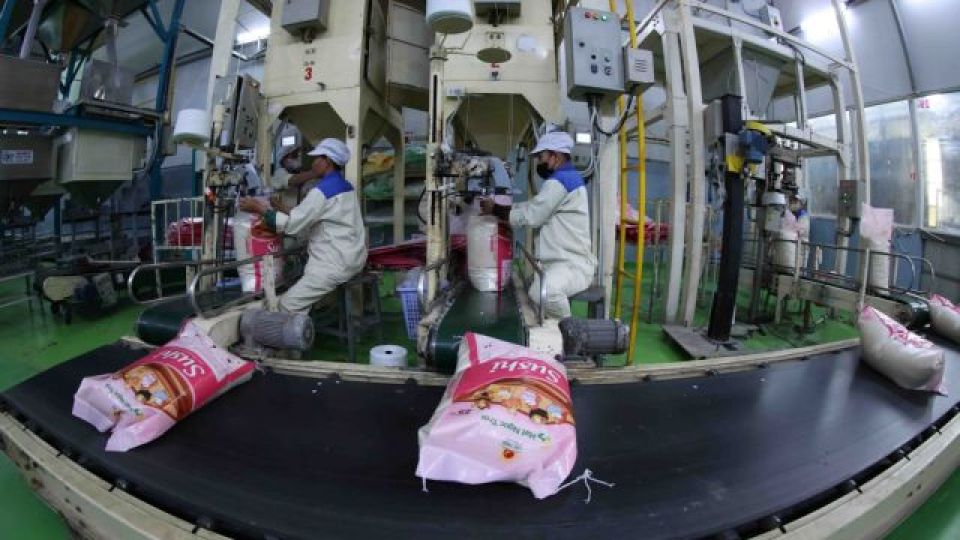September 12, 2025
HANOI – It is critical to diversify export markets, improve added value and develop brand recognition for Vietnamese rice so exports can continue expanding, even as major markets have halted imports.
Minister of Industry and Trade Nguyễn Hồng Diên spoke at the conference held on Wednesday with the Ministry of Agriculture and Environment to discuss solutions for implementing the Prime Minister’s official dispatch on boosting rice exports and ensuring market stability after top buyers suspended rice imports, raising concerns over short-term pressure on rice prices and consumption.
Earlier this month, Indonesia, one of Việt Nam’s top buyers, said it would halt rice imports for the rest of 2025 due to abundant domestic supply. In July, the Philippines, which accounts for around 40 per cent of Việt Nam’s rice shipments, suspended purchases for two months from the beginning of September, leaving around 500,000 tonnes stranded.
The ministry’s statistics show that Việt Nam exported nearly 6.3 million tonnes of rice worth more than US$3.2 billion in the first eight months of 2025, up 3.7 per cent in volume but down 15.4 per cent in value year-on-year. The Philippines was the largest buyer with 2.9 million tonnes, up 4.2 per cent, followed by Ivory Coast with 750,000 tonnes and Ghana with 660,000 tonnes. Exports to Indonesia dropped 97.2 per cent to just 25,000 tonnes.
Deputy Minister of Agriculture and Environment Trần Thành Nam said efforts would be increased to prevent congestion during peak harvest as the summer-autumn harvest is expected to wrap up by mid-September and the autumn-winter crop is set to peak in November and December with an estimated paddy output of 14.5 million.
The agriculture ministry estimated paddy output to total 43.5 million tonnes this year, of which about 15 million tonnes of paddy, equivalent to 7.5 million tonnes of milled rice, are available for export.
Optimism
Trần Xuân Hà, vice president of the Việt Nam Food Association, said that the Philippines’ rice import suspension can be just temporary.
It is likely that they will resume imports by late October or in November – December to ensure supplies for the year-end holidays, he said, adding that some Vietnamese firms had already received asking from Philippine buyers.
The association urged exporters to stay calm, closely watch the market and diversify markets to reduce reliance on a market. Purchases should be considered to ensure stocks when export opportunities return.
Vietnamese Trade Counsellor to the Philippines Phùng Văn Thành said that the Phillippines remains dependent on imports for rice supply. This country produced only 9.08 million tonnes of paddy in the first half of 2025 while the full year-target is estimated at 20.46 million tonnes, meaning a need to import around 4.9-5.4 million tonnes this year.
According to Diên, temporary halts by the Philippines, Indonesia or other traditional markets were not unusual as those countries have not yet been fully self-sufficient of food. There is ground for expectation that these markets will resume imports, he added.
Diên said that Việt Nam is still on track to reach its export target of eight million tonnes for the full year, with nearly 80 per cent of the goal already achieved.
Long-term solutions
“The import suspensions by major buyers help us learn an important lesson: we must diversify markets and avoid dependence on a few. Only when the market is expanded and balanced, can we minimise risks and respond effectively to fluctuations,” Diên noted.
He also stressed the importance of enhancing the value of Vietnamese rice and strengthening its brand reputation and quality in the global market.
Diên urged a close watch on the Philippines’ suspension of rice imports and Indonesia’s moves, with market updates provided promptly, so that exporters can respond quickly to any changes, along with stepping up efforts to expand to Africa, the Middle East, South Asia, West Asia and South America.
He also urged stronger negotiations to sign or upgrade rice trade agreements and the application of green farming and traceability, with a wider rollout of Việt Nam’s programme to develop one million hectares of low-emissions, high-quality rice.
Exporters must also improve rice quality to meet the requirements of import markets and diversify products, including for premium and niche segments, Diên said.
To support businesses, Diên urged the Ministry of Finance and the State Bank of Việt Nam to speed up VAT refunds, simplify customs clearance during peak demand, expand credit and provide timely loans for purchasing and storage.
According to the director of the trade ministry’s Import – Export Department, Nguyễn Anh Sơn, the rice industry needs a comprehensive strategy to secure long-term growth and competitiveness, focusing on market diversification and regulatory reforms.
Regulations on rice businesses are being amended to develop a more transparent and business-friendly framework, with an aim of encouraging greater participation from the private sector and small- and medium-sized enterprises.
Sơn stressed the need for strict market oversight to ensure fairness, eliminate fraud and protect the legitimate rights of producers and exporters, not only to boost exports but also to safeguard domestic food security, contribute to global food supplies and strengthen Việt Nam’s recognition as a responsible rice exporter.
Việt Nam’s rice exports reached a record high of 9.18 million tonnes worth $5.75 billion in 2024, representing a year-on-year increase of 12.9 per cent in volume and 23 per cent in value, securing its position as the third largest rice exporter in the world, after India and Thailand. — VNS


